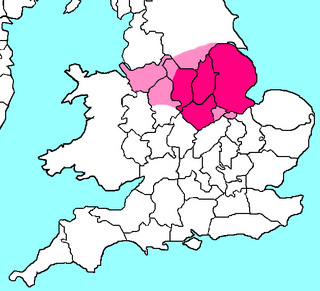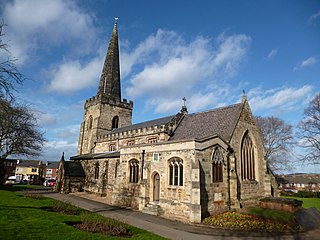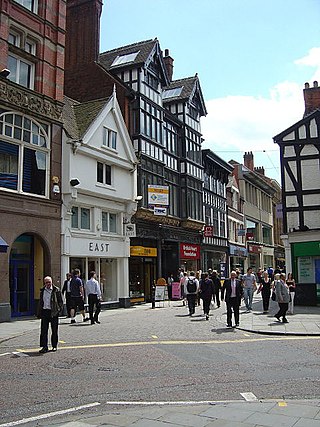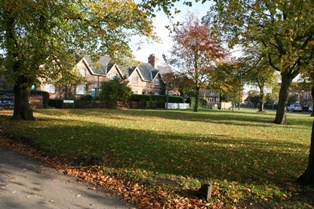
Long Eaton is a town in the Erewash district of Derbyshire, England, just north of the River Trent, about 6 miles (9.7 km) south-west of Nottingham and 9 miles (14 km) south-east of Derby. The town population was 37,760 at the 2011 census. It has been part of Erewash borough since 1 April 1974, when Long Eaton Urban District was disbanded.

Arnold is a market town in the Borough of Gedling in the county of Nottinghamshire in the East Midlands of England. It is situated to the north-east of Nottingham's city boundary. Arnold has the largest town centre in the Borough of Gedling and the most important town centre in the northeastern part of the conurbation of Greater Nottingham. Gedling Borough Council is headquartered in Arnold. Since 1968 Arnold has had a market, and the town used to have numerous factories associated with the hosiery industry. Nottinghamshire Police have been headquartered in Arnold since 1979. At the time of the 2011 United Kingdom census, Arnold had a population of 37,768.

Bingham is a market town and civil parish in the Rushcliffe borough of Nottinghamshire, England, 9 miles (14 km) east of Nottingham, 12 miles (18.8 km) south-west of Newark-on-Trent and 15 miles (23.3 km) west of Grantham. The town had a population of 9,131 at the 2011 census, with the population now sitting at 10,080 from the results of the 2021 census data.

The North Midlands is a loosely defined area covering the northern parts of the Midlands in England. It is not one of the ITL regions like the East Midlands or the West Midlands.

The schools in England are organised into local education authorities. There are 150 local education authorities in England organised into nine larger regions. According to the Schools Census, there were 3,408 maintained government secondary schools in England in 2017.

Stapleford is a town and civil parish in the Borough of Broxtowe, Nottinghamshire, England, 6 miles (9.7 km) west of Nottingham. The population of the civil parish at the 2001 census was 14,991, at the 2011 census it was 15,241, and 15,453 at the 2021 census.

Southwell is a minster and market town, and a civil parish, in the district of Newark and Sherwood in Nottinghamshire, England. It is home to the grade-I listed Southwell Minster, the cathedral of the Anglican Diocese of Southwell and Nottingham. The population of the town was recorded at 7,491 in the 2021 census.

Beeston railway station serves the town of Beeston in Nottinghamshire, England. It lies on a spur of the Midland Main Line and is managed by East Midlands Railway. It is situated 3.2 miles (5.1 km) south-west of Nottingham railway station and 750 metres (0.5 mi) south-east of Beeston transport interchange, for local bus services and Nottingham Express Transit trams. The station building is Grade II listed.

Nottingham City Council is the local authority for the city of Nottingham, in the ceremonial county of Nottinghamshire in the East Midlands region of England. Nottingham has had a council from medieval times, which has been reformed on numerous occasions. Since 1998 the council has been a unitary authority, being a district council which also performs the functions of a county council. Since 2024 the council has been a member of the East Midlands Combined County Authority.

Bridlesmith Gate is a pedestrianised shopping street in the city centre of Nottingham, England. It is located between Middle Pavement and Victoria Street. St. Peter's Gate and Bottle Lane stem off it along with Byard Lane.

Mansfield railway station serves the town of Mansfield in Nottinghamshire, England. It was also known as Mansfield Town, to distinguish itself from the GCR's former Mansfield Central and Mansfield Woodhouse stations. It is a stop on the Robin Hood Line, located 17 miles (27 km) north of Nottingham; it is managed by East Midlands Railway. The station building is Grade II listed.

Flintham is a village and civil parish in the Rushcliffe district in Nottinghamshire, 7 miles from Newark-on-Trent and opposite RAF Syerston on the A46. It had a population of 597 at the 2011 census, estimated at 586 in 2019, and a fall to 563 at the 2021 census. The village name was taken by the Ham class minesweeper HMS Flintham.

Wilford is a village and former civil parish in the Nottingham district in the ceremonial county of Nottinghamshire, England. The village is to the northeast of Clifton, southwest of West Bridgford, northwest of Ruddington and southwest of Nottingham city centre. It is at a meander of the River Trent.
Thomas Cecil Howitt, OBE was a British provincial architect of the 20th Century. Howitt is chiefly remembered for designing prominent public buildings, such as the Council House and Processional Way in Nottingham, Baskerville House in Birmingham, Newport Civic Centre, and several Odeon cinemas. Howitt's chief architectural legacies are in his home city of Nottingham. He was Housing Architect for the City Council, designing municipal housing estates which are often considered to be among the finest in terms of planning in the country.

The Smithbaronetcy, of East Stoke in the County of Nottingham, is a title in the Baronetage of Great Britain. It was created on 31 October 1757 for the banker George Smith, High Sheriff of Nottinghamshire from 1757 to 1759. He was the eldest son of Abel Smith I (1686–1756) of Nottingham, the 2nd son of Thomas Smith I (1631–1699), the founder of Smith's Bank in Nottingham. His younger brothers included: Abel Smith II, and John Smith, ancestor of Julian Pauncefote, 1st Baron Pauncefote.

All Saints' Church, Winthorpe is a Grade II listed parish church in the Church of England in Winthorpe, Nottinghamshire, England. The current building, the construction of which was completed in 1888, is at least the third version of the church, which dates back to at least the early 13th century. All Saints' Church was commissioned by the church rector, Edward Handley, in memory of one of his relatives.
The following is a timeline of the history of the city of Nottingham, England.

Thomas Simpson was an English architect based in Nottingham.

Sir George Smith, 1st Baronet (1714–1769), of Smith House, Angel Row, Nottingham, and of Stoke Hall in the parish of East Stoke in Nottinghamshire, was a member of the Smith family of bankers, who established Smith's Bank in Nottingham in 1658. He was created a baronet "of East Stoke in the County of Nottingham", a title in the Baronetage of Great Britain, on 31 October 1757.
Rosalys Coope (1921-2018) was a much respected architectural historian. As well as an academic and researcher she served in the Women's Royal Naval Service during World War II.




















